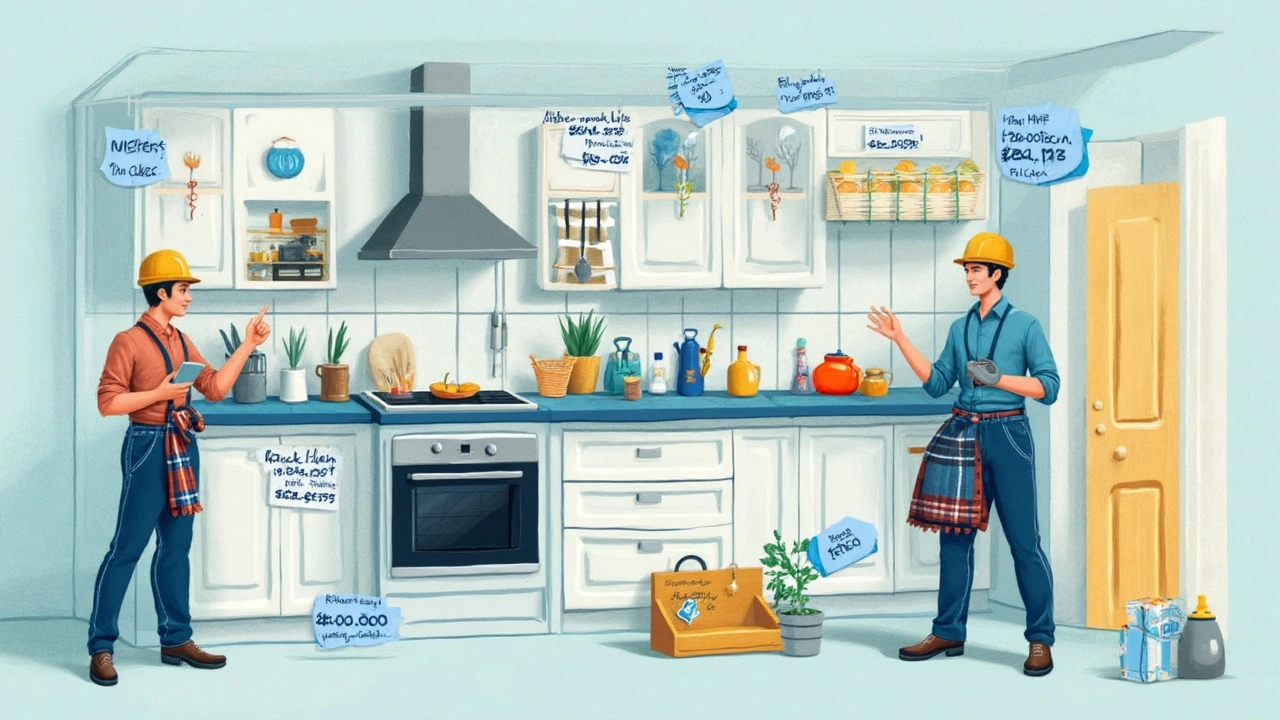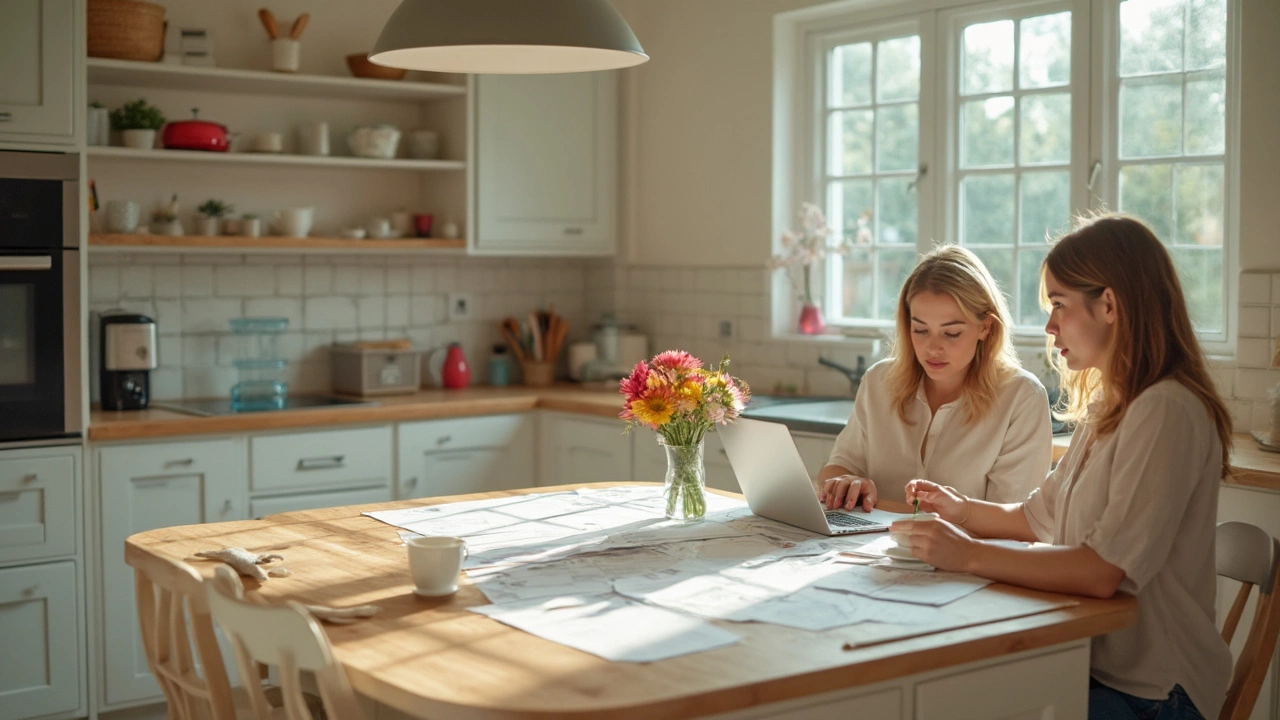So, you've wandered through those IKEA kitchen displays, maybe snapped a few pictures on your phone, and started dreaming of your perfect, organized space. Here's a twist nobody expects: that price tag next to the glossy cabinet isn’t the only number you’ll need to worry about. Building a full IKEA kitchen is like putting together a puzzle where each piece (cabinet, handle, countertop, installation) has its own price, and the final number will surprise almost everyone. Plenty of people take a peek at IKEA's site thinking a kitchen facelift is just a click and a quick cart away, but things get real fast—especially if you don’t do your homework.
The True Cost of an IKEA Kitchen: Let's Get Specific
First off, there is no single “IKEA kitchen cost” because everyone’s kitchen and taste are different. But here’s the real, nitty-gritty math people want to know. IKEA’s own stats and online planners reveal that, as of 2025, most small kitchens (let’s say under 100 square feet) with the basics, like wall and base cabinets, fronts, drawers, hinges, and soft-closing dampers, generally start at about $4,500 just for the cabinets and hardware. If you want uppers stacked up to the ceiling or fancy inserts for pan racks and lazy Susans, tack on another $1,000 to $2,000 easily.
Medium and large kitchens will push the price up just from square footage. A family-sized kitchen (150–200 square feet) could reach $7,000–$10,000 for typical cabinets and doors. That’s not counting clever storage solutions, glass fronts, or upgraded drawer organizers—add $500 for every time you say, “That’s cool, I want one.” And if you’re like me and get ambitious at the kitchen planning terminal, the total can reach $12,000+ before anything is installed. Keep in mind, IKEA kitchens use the SEKTION line (introduced in 2015)—one bookshelf-size frame for base, wall, and tall cabinets, but endless customizations with fronts, handles, and interior organizers. The more options you explore, the higher your final bill climbs.
Here’s a weird fact: countertops are never included in those front-and-center sample prices. IKEA’s laminate countertops look affordable—$100 to $300 for a standard eight-foot length—but the trend now is quartz or butcher block. IKEA’s pre-cut quartz can run $800 for just one 74-inch section. Most kitchens need at least two. Installing a breakfast bar or L-shape might call for a custom order, which adds both weeks of wait and a chunk of change (custom quartz often leaps over $2,000 just for counters). Add in under-mount sinks and integrated cooktop cutouts, and the price rises again.
Appliances are another cost silo. IKEA has their own branded dishwashers, ovens, ranges, microwaves, and more, all designed to fit with SEKTION cabinets—but, quality-wise, think mid-range rather than high-end. A full set of basic white appliances costs about $2,200 to $3,500. Want stainless steel? Maybe $4,000. Prefer Bosch, GE, or another brand? Head to your favorite appliance store and add your numbers to the spreadsheet.
Then there’s installation, and here’s where even experienced DIYers get humbled fast. If you’re handy, you can save by assembling the cabinets yourself—IKEA is famous (or infamous) for its flat-pack system. But turning those boxes into a level, plumb, kitchen-worthy setup is more complicated than the Hemnes dresser you wrestled home. Officially, IKEA partners with assembly/install pros—pricing varies, but $2,000–$4,500 is normal for a full kitchen with counters. That’s cabinets, rails, fillers, toe kicks, end panels, and door/drawer alignment. Add more if you want them to do appliances or lighting, and double-check if sink plumbing or hood venting is included (usually, it’s not).
Don’t forget things like cabinet pulls, lighting, garbage/recycle solutions, under-cabinet lighting, tile backsplash, or new plumbing connections. IKEA’s soft-close hinges and pretty glass doors can tempt you, but every extra is a little surcharge. Even at IKEA you can click your way to a $15,000 kitchen in minutes if you choose upgraded materials and all the trending extras.
And let’s lay out the surprise costs people rarely plan for: Permits and inspections (if you’re moving plumbing or gas), old kitchen demo and disposal (expect a few hundred to $1,500), plus possible long waits if pieces are out of stock, which happened like clockwork during the COVID-19 years and still crops up now in 2025.

Tips and Smart Moves When Planning Your IKEA Kitchen
Here’s a fact: the average guy or gal who walks into IKEA looking for kitchens has no idea how much storage or what size cabinets they actually need. The IKEA online kitchen planner is a game changer if you use it right. My friend Oliver spent hours sticking fake cupboards onto a virtual wall and found out he was about to buy two extra cabinets that would have crashed into a window if he hadn’t measured first.
Always double check your kitchen’s dimensions before you start clicking everything into your cart. This sounds basic, but people mess it up all the time (I once saw a neighbor eating takeout in plastic chairs for six months after their kitchen order arrived and half of it didn’t fit). Print out your kitchen layout, then measure doors, window sills, baseboards, and ceiling heights. SEKTION cabinets are modular in increments of 15, 18, 24, 30, or 36 inches, so working these into your walls is like playing grown-up Tetris.
Don’t forget about clearance for drawers and appliances. If your fridge or dishwasher door can’t swing open fully because you squeezed in too many cabinets, you’ll regret it every single day. IKEA has fill strips, panels, and “hack” pieces to solve tight spaces, but planning is always cheaper than improvising late.
Hardware is the silent wallet-drainer. Drawer pulls and handles are sometimes $3 each—which adds up fast across twenty doors. Under-cabinet lighting brings the look together but is almost never included in the kitchen price you see first. IKEA’s Omlopp and Mittled series are easy to install, but you’ll still pay $100–$300 for lighting kits, drivers, and extras. Want wireless phone charging built into a drawer? IKEA sells those, too, for another upcharge.
Countertops are where people make the costliest mistakes. Those cheap laminate tops work fine for rental units, but if you spend any time in the kitchen, quartz is worth the extra cost. Be careful with IKEA’s measurement and installation service; they require you to have all your cabinets secured and appliances on site before the countertops get measured, which can mean weeks of waiting without a usable kitchen. Budget for takeout if this happens.
If you lean toward a custom touch, try IKEA “hacks” to update the basic frames. Some companies, like Semihandmade or Reform, sell doors and drawer fronts made to fit IKEA’s cabinets, letting you mix lux looks with flat-pack savings. This adds cost, but the kitchen will look like you hired a designer.
Do you need professional installation? If you’ve got skills (or stubborn confidence), handling IKEA assembly is doable. Each cabinet can take thirty minutes to an hour to assemble, more if you mix up the hinges or get a mislabeled back panel (happens with large orders occasionally). If you’re not 100% level with the rails, your cabinets will be off. Official installer quotes run from $85–$145 per cabinet, with extra fees for cutting end panels or fitting around tricky plumbing setups.
My wife Sophia used to think we’d save a fortune by doing everything ourselves. Fast forward: I spent three weekends hunched over a half-built island, thinking I’d lost my mind (and my Allen wrench) somewhere around cabinet number six. If you value your weekends, let the pros handle at least the mounting and leveling. You can always save the finishing touches for yourself.
Lastly, keep a little flexibility in your budget for unexpected headaches. Need to reroute a pipe or update old electricity? That’s rarely included in kitchen quotes, and even IKEA’s official install teams won’t touch complicated electrical or plumbing work.

FAQs and Hidden Details: What IKEA Doesn’t Put on The Price Tag
IKEA kitchen cost is always at the center of kitchen remodeling searches, but the devil is in the details. Here are questions I hear often and what you really need to know before pulling the trigger.
- How much does a basic, small IKEA kitchen cost? The bare minimum for a full kitchen (think studio or tiny condo) is around $4,500 for cabinets. Toss in budget counters, and you’re up to about $6,000 before appliances.
- How much does a mid-sized, family kitchen cost with average choices? Budget at least $9,000–$12,000 for cabinets, countertops, hardware, typical appliances, and basic install. Bump up the materials or pick fancier finishings, and you’ll break the $15,000 mark much faster than you planned.
- Is IKEA cheaper than custom cabinets? For the most part, yes. Custom cabinetry can double or triple costs, stretching your price to $25,000 or more. IKEA’s SEKTION system’s price is one of its main selling points, with consistent quality and a 25-year warranty on hardware.
- What’s NOT included in the price? The “kitchen starting at…” sign leaves out demolition, plumbing, electrical changes, professional installation, tile backsplash, most lighting, and delivery charges (typically $300–$500 for a large order). The real budget kicker? Waiting weeks for parts if an item’s out of stock.
- Will my IKEA kitchen look custom? Yes—if you play around with materials and finishes. White cabinets with grey quartz counters? Modern. Blue or green fronts with wood accents? Classic or vintage. Want fancy? Try glass doors, custom pulls, LED light strips, and a funky backsplash tile from Home Depot to stand out.
- How long does it take? If everything’s in stock, your kitchen can go from boxed to “pizza night at the new counter” in two to three weeks—if you use a pro installer. DIY? Add a few weekends, or more if you only work evenings. If you need custom counters, add another two weeks (at least) from measure to install.
- What about durability? It’s not all smooth sailing. SEKTION cabinet boxes are made with high-density particleboard, which stands up well if kept dry and mounted solidly, but don’t expect battleship-level toughness. Water leaks, especially around dishwashers or sinks, can ruin boxes fast if unnoticed.
A sneaky reality: IKEA kitchen prices have barely crept up over the years, but labor and material costs outside of IKEA (install, electrical, plumbing, custom counters) keep climbing. Where you live also matters—a kitchen bought and installed in New York or San Francisco averages 20% higher than in small cities.
The biggest money-saving tip: Wait for IKEA’s twice-yearly kitchen sales (usually early spring and late summer). You can sometimes score 10–20% off everything, including installation, just by timing your purchase right. If you’re patient, these deals often roll around when you least expect them—and the savings are real.
IKEA gives you quality and flexibility, but watch out—it’s all too easy to make choices that double your original budget. Plan every inch, compare materials, and don’t skimp on the things you’ll touch every day. I’ll say this: No single kitchen is truly cheap or easy, but getting your dream space without drowning in costs? That’s where the real magic happens.
